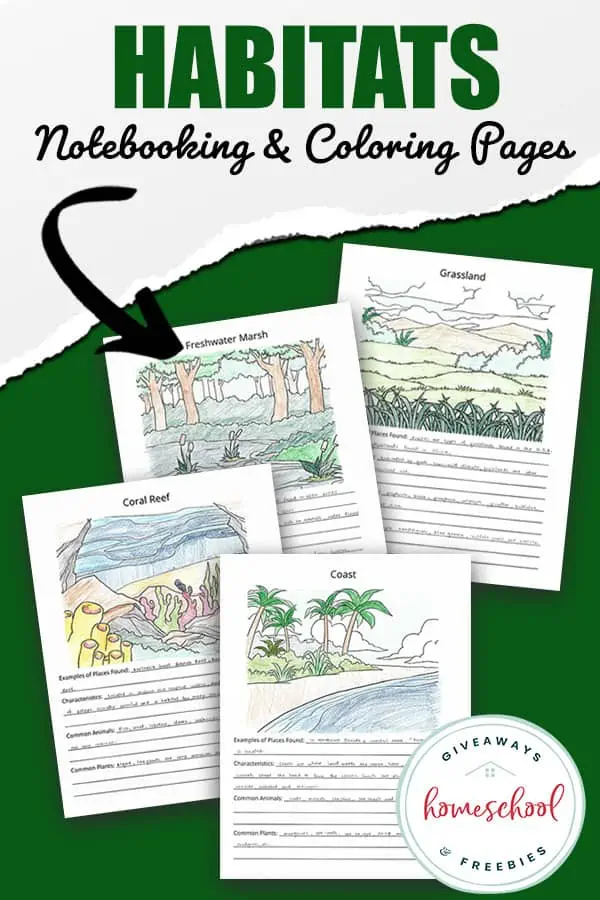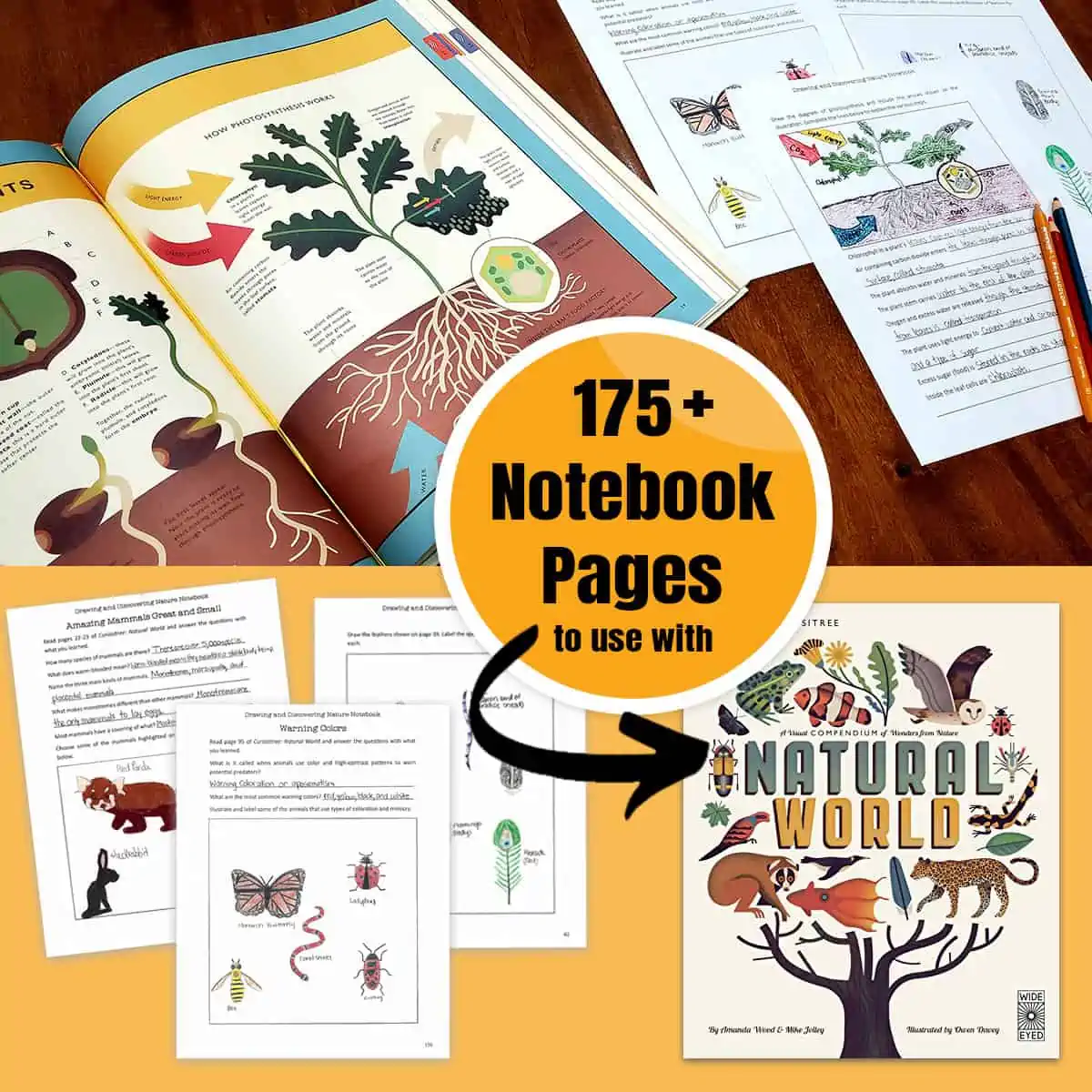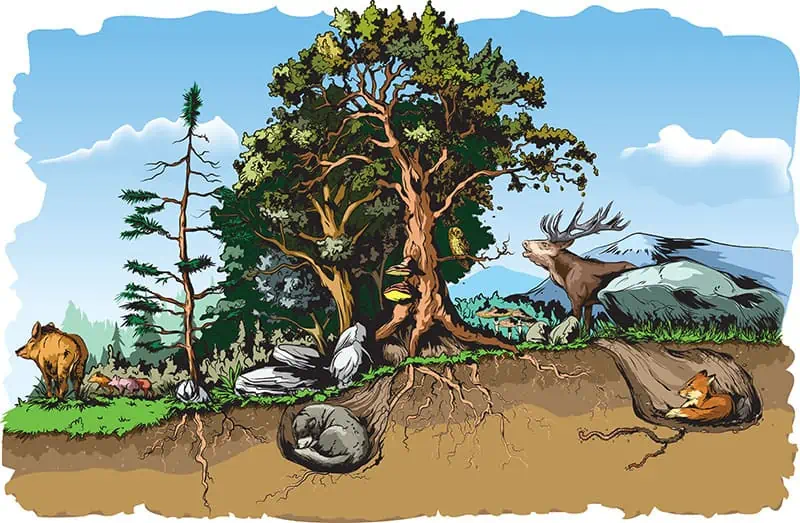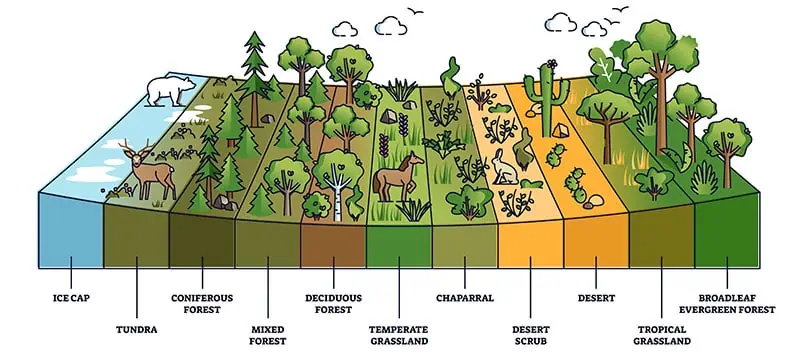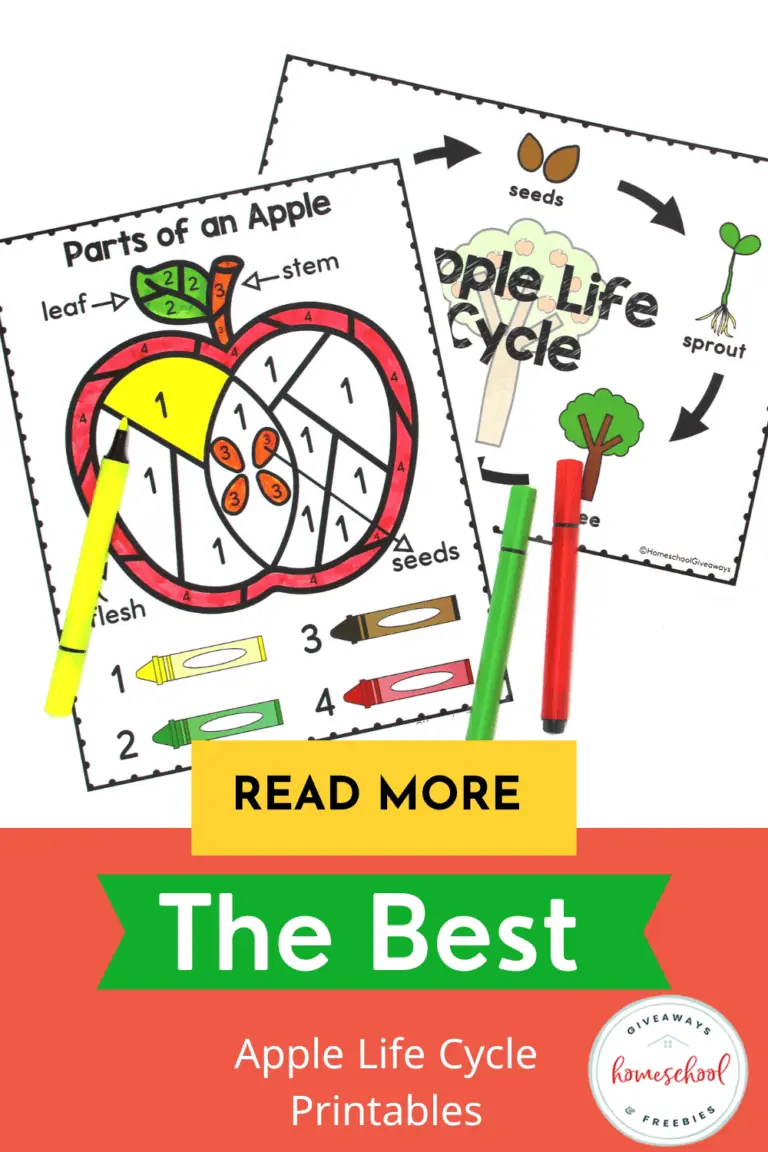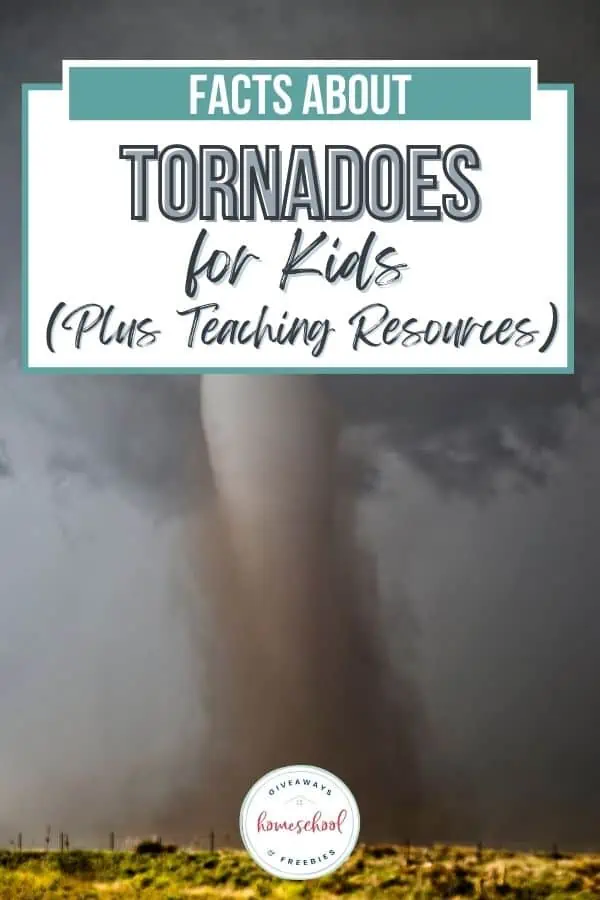Learning About Animal Habitats Around the World
Published:
May 19, 2022
Contributor:
Jeannette Tuionetoa
Disclosure: This post may contain affiliate links, meaning if you decide to make a purchase via my links, I may earn a commission at no additional cost to you. See my disclosure for more info.
Are you ready to learn about animal habitats? Explore the various habitats of animals – from tropical forests, grasslands, and tundra to the mountains and polar regions and everything in between. Discover all you need to know about the places where animals live and even download a free animal habitats notebooking set with coloring pages.
Animal Habitats
Through creation, God has made a way to teach us and provide for us. The Bible often references the provisions God has made for His creatures. Learning about animal habitats and types of biomes helps students see His glory in creation.
Types of Animal Habitats
There are many different types of habitats that animals call home. If you ask someone, they may name six animal habitats: forests, grasslands, desert, tundra, and two aquatic habitats.
We are going to cover land habitats and water habitats and really break them down for you. They each are unique and make perfect environments for the animals in them to thrive abundantly.
Read on to learn more about these habitats and be sure to grab the free animal habitats resource we have for you at the bottom of this post.
Let’s explore the following habitats where animals live:
- Tropical Forests
- Temperate Forests
- Grasslands
- Deserts
- Mountains and Polar Regions
- Polar
- Tundra
- Savannah
- Freshwater Habitats
- Rivers
- Lakes
- Ponds
- Streams
- Oceans and Seas
- Coastal Habitats
- Estuaries
- Coral Reefs
Free PDF Download: Habitats Notebooking and Coloring PagesBe sure to scroll to the bottom of this post to gain access to our free habitats notebook. |
What is an animal habitat?
An animal’s habitat is its natural home environment, where they live. In animal habitats, the animals can find food, raise their young, and find a means of protection from predators and weather.
Habitats Versus Biomes
Animal habitats are different from biomes.
Comparatively, a biome is not just where an animal lives, but an ecosystem characterized by both plants and animals that live there – as well as the climate, vegetation, and rainfall.
Learn more information on different types of biomes, as they make a great precursor to the animal habitats topic.
Habitats and Microhabitats
A habitat is where living organisms can be found. A microhabitat is a very specific subsection of habitat for animals and insects. Microhabitats are smaller than habitats. Animals (species) within a habitat tend to have a preference for different microhabitats.
Where the habitat would be grasslands, a microhabitat would be a temporary pool of water after rain on the grasslands. Where the Amazon Rain Forest is a habitat, underneath a log would be a microhabitat. Usually, microhabitats are small-animal habitats or where insects dwell.
Habitat Needs
Since animals live in different habitats, there are several things that a basic habitat needs in order to provide for the species in them. When students think about the various habitats in a biome, they begin to understand that species survive because their habitat is conducive to their survival.
A habitat needs food, shelter or protection from predators and weather, and lastly suitability to raise offspring. For example, an arctic hare is found in the Arctic. They eat a wide range of foods like berries, leaves, seaweed, plants, and other things depending on the weather.
The arctic hare also has thick camouflaged seasonal fur and heavily padded paws of fur for the winter cold and snow. They also burrow into the ground or under the snow during extremely cold weather.
Recommended: Drawing and Discovering Nature NotebookExplore the world’s habitats and the animals that live there with Curiositree: Natural World and the Drawing and Discovering Nature Notebook |
Animal Habitats
Learn more about animal habitats and their characteristic below.
Terrestrial or Land Habitats
The Earth has several different types of land or terrestrial habitats. In terrestrial habitats, plants and animals live in or on the land mostly, and they vary from having very rainy climates to very dry climates. Therefore, the plants and animals who call the land ecosystems home are most influenced by the amount of moisture that land has.
The amount of moisture determines what animals and plants can live on that land, the type of soil it has, how much (if any) rain or snow is present throughout the year, how cold the area gets, and how many nutrients are available on the land, also whether or not the land gets flooding or not.
Check out the information below on terrestrial/land habitats.
Forests
Forest habitats provide a home for various types of animal and plant life. An assortment of trees cover the forest floors and create a canopy over the wildlife. Forests are an abundant life source for species that inhabit them because of their different layers for species and animals to live in.
Forest habitats have a forest floor where loads of insect species live and debris and leaves are recycled. There is an herb floor where wildflowers, ferns, tree seedlings, and grasses grow. The shrub layer is where bigger plants grow along with shrubs and bushes.
The understory is where there are newer trees growing, the canopy is where the leaves and branches intertwine concealing the top of the forest. Finally, the emergent layer above the canopy is where trees grow high above the rest.
All of these layers form specific habitats for swarms of animal species and plant life to thrive. Grab a forest animals printable to learn more about the animals that live there.
Types of forest habitats:
There are different types of forest habitats. There are dry forests, wet forests, and rainforests. There’s also temperate forests and boreal forests (taiga). The two main types we will cover are tropical forests and temperate forests.
Tropical Forests
Tropical forests are home to thousands of native wildlife species, including some that are rare and even endangered animals.
They are rich in vegetation the animals use as food and shelter even. The richness of vegetation is due to the topography, quality of soil, rainfall, and temperature. These characteristics are particularly beneficial to birds, mammals, reptiles, and amphibians living there. You can learn more about animals of the rain forest and print some free worksheets.
Temperate Forests
Much like its name, temperate forest habitats have an environment that experiences seasons like hot summers, cold winters, and cool springs and fall seasons. They get enough rainfall each year (30 to 60 inches) to help the trees in them grow.
Because of the changing seasons, animals adapt to them well to survive. For instance, animals like bobcats and grizzly bears grow think coats to help them in the winter. Squirrels and chipmunks gather nuts in the fall to store for the winter.
Grasslands
The grassland habitat is characterized by large fields of land that are mainly without trees. They have limited and unpredictable rainfall and often experience droughts. The droughts often cause fires. However, the wildfires actually help the environment stay healthy for the species in it.
Nutrients are released into the soil by microbes when the temperature gets hotter and the stems and buds grow quickly since they grow underground.
The grassland habitats are dominated by grassy areas, the climate is semi-arid, and are located near the interiors of continents. Because of its open spaces, mammals like bison, horses, antelope, and jackrabbits roam across the land. You can learn more about grassland habitat animals and even print some free resources to enhance your study.
Deserts
Deserts receive fewer than 10 inches of rain per year and are the driest places on the planet Earth. Some deserts are extremely cold and others are extremely hot.
When just looking at deserts from the outside in, it looks as though nothing can live there. However, most deserts are full of animals and plant life that has adapted to live there with little or no water.
For example, cacti store enough water to last them from one rain to the next, and kangaroo rats get water from the seeds they eat. Most desert animals hunt at night and stay underground or under microhabitats like rocks during the day.
If you are looking for a way to teach about desert animals for kids, we’ve got you covered!
Mountains
Mountain habitats rise well above the foothills and flat terrain. These habitats provide food, shelter, and breeding or nesting areas for the wildlife living there.
Mountainous habitats many times have snow that has fallen on them and melts in the springtime. That melted water from the fallen snow runs into lakes, streams, rivers, and reservoirs which benefits both people and wildlife.
Not much wildlife grows or wild animals live at the mountain tops since the air becomes colder and thinner the farther up the mountain is.
Most mountains have extreme climates so the animals living there have awesome adaptations. For instance, coats are thick to stay cool at night, and animals like the snow hare have snow-white coats to camouflage from the mountain lions and snow leopards.
Polar
Kids must wonder how animals can survive in the extreme cold, yet the seals swim in and out of the water with ease and polar bears stroll the polar regions with no problem at all.
Polar habitats in the Arctic Ocean aren’t lands at all, but are large continually shifting sheets of ice. The Antarctician polar habitats are land but are completely covered in a layer of ice which is three miles thick in width in some areas.
It is so cold that not much can grow in polar habitats, as there is no room for them to grow deep roots. Under the surface of the ground is a layer of ice called permafrost.
Tundra
The word tundra comes from the Finnish word tunturi which means treeless plain. The tundra habitat has extremely low temperatures, very little precipitation, poor nutrients, and a growing season that is quite short.
The tundra habitat is covered by snow for much of the year and wildflowers burst with colors in the summer. Because of the cold, there are only 48 species of tundra animals that live in this habitat like the snowy owls and caribou.
Savannah
The savannah habitats are covered in tall grasses with scattered bushes and trees. The plant life and trees survive through drought and animals graze throughout the seasonal rain and dry seasons.
The savannah habitats are warm year-round because they are near the equator. The dry season is really dry and the wet seasons are so wet they are often called the monsoon season which helps grasses grow and flourish suitable for many plants and animal life.
The plants that grow there have long roots that store moisture since they must survive so long without rain. The plants supply food to large herbivores like zebra, giraffes, and buffalos.
Aquatic or Water Habitats
Aquatic habitats are the wettest of all habitats, as they are actually – water. Aquatic habitats are made up of water and all things that species need to survive like food, shelter, and gravel beds or seagrass for breeding.
These habitats aren’t just water. They have to be the right type like freshwater, estuarine, or saltwater, the temperature has to be right, the quantity has to be specific in depth and flow, and the quality also has t be just right for the habitat to thrive.
Freshwater Habitats
Habitats made of freshwater include wetland habitats (i.e. marshes, swamps), rivers, lakes, creeks, and streams.
Freshwater habitats only make up 3% of the planet’s water habitats. Although this seems low, the freshwater habitats on the planet account for 100,000 different plant and animal species. Learn more about freshwater marsh animals and print some free aquatic ecosystems worksheets.
Rivers
Rivers are large running bodies of water with a variety of natural plants and animals living in and around them.
Habitats in river areas are the river beds, water channels, and river banks (including land trees, and water-loving animals and plants – called the riparian zone). Rivers also have floodplains and flatlands spreading out from the channels.
Lakes
Large standing bodies of water are lakes (some natural, some man-made). Tiny crustaceans, planktonic algae, rushes, and various fish live in this habitat. These species require permanent water sources for food, shelter, and breeding.
Ponds
Pond habitats are bodies of water that hold water for four months to a year or more. Ponds can be found in towns, villages, farmland, grasslands, gardens, and more.
They make a great environment for wildlife to thrive like water lilies. Some animals spend the first stages of their life in ponds like frogs as tadpoles.
Streams
Stream habitats are small running waters formed by natural processes. At times, streams are present or not, or partly present depending on the season. Streams support plant life and animals that tend to depend on running water like salmon, crayfish, and trout.
Marine Habitat
Marine waters habitat is defined by waters that are salty (35g of salt for every kilogram of water). 70% of the Earth’s surface is from the oceans and seas of the marine habitat.
The habitats in marine waters have many species of animals and aquatic plants. Marine habitats are affected by the depth of water, distance from the shore, ocean currents and tides, light, temperature, nutrients, and pressure.
Marine habitats are very different depending on the temperature of the waters.
Oceans and Seas
Ocean habitats can be divided into two different segments, open ocean habitats, and coastal habitats.
A sea is a small area of an ocean with land on several sides while an ocean is a vast ocean we think of that stretches as far as the eyes can see. From microscopic animals like zooplankton to the largest mammal to ever be recorded on the planet the blue whale, the ocean holds incredible creatures.
Algae like seaweed and kelp grow in the ocean zone providing food and shelter to marine animals.
Learn more about the ocean and the various animal that live there with these open and go resources: |
||||
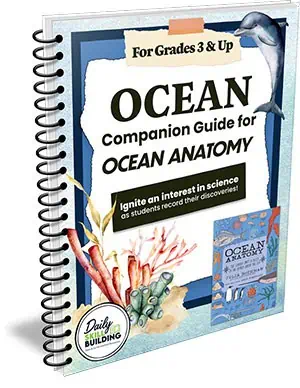 |
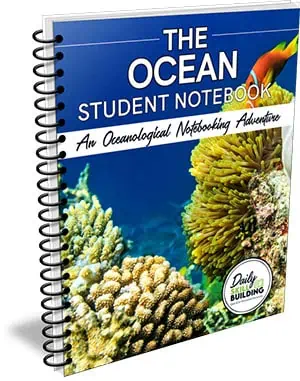 |
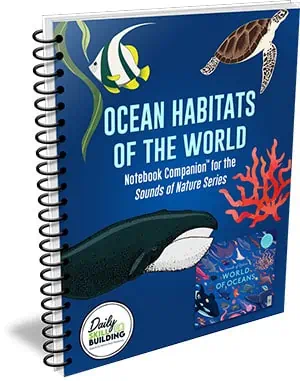 |
||
Coastal Habitats
Most life in this marine habitat is found in the coastal environment. Coastal habitats are close to the sea and include habitats like coastal dunes, sandy shores, cliffs, beaches, and supralittoral habitats.
Estuaries
Estuaries are natural habitats where rivers and oceans meet and water is still salty somewhat. They have a mix of saltwater and freshwater and are home to oysters, crabs, birds, and other animals that thrive in brackish water.
Coral Reefs
Warm and tropical waters have coral reef habitats that are full of colorful tiny fish and species. Different animals like seahorses, clownfish, and sea turtles are found on coral reefs, but most interesting is that the corals are animals as well.
Coral reefs have often been called the rainforests of the sea because of the wide variety of animals that live there.
Scripture on Animals and Creation
When your students study animals and their habitats, there are Bible verses that you can use for copywork or memory verses. The below Bible verses are perfect to go alongside your lesson plans on God’s great creation.
Romans 1:20 (ESV) For his invisible attributes, namely, his eternal power and divine nature, have been clearly perceived, ever since the creation of the world, in the things that have been made. So they are without excuse.
Isaiah 43:20-21 (ESV) The wild beasts will honor me, the jackals and the ostriches, for I give water in the wilderness, rivers in the desert, to give drink to my chosen people, the people whom I formed for myself that they might declare my praise.
Job 12:7-10 (ESV) But ask the beasts, and they will teach you; the birds of the heavens, and they will tell you, or the bushes of the earth and they will teach you, and the fish of the sea will declare to you. Who among all these does not know that the hand of the Lord has done this? In his hand is the life of every living thing and the breath of all mankind.
Free Habitats Notebooking and Coloring Pages PDF
Download our free notebooking and coloring pages for the following habitats: cave, city, coast, coniferous forest, coral reef, desert, farm, freshwater marsh, grassland, mountain, ocean, polar, pond, river, savanna, temperate forest, tropical forest, and the tundra.
How to Download Habitats PDF Printables
To get access to the free habitats notebook, sign into the subscriber library using the password found in all our emails. Not yet a subscriber? No worries – sign up below to get access now!
[magicactionbox]


